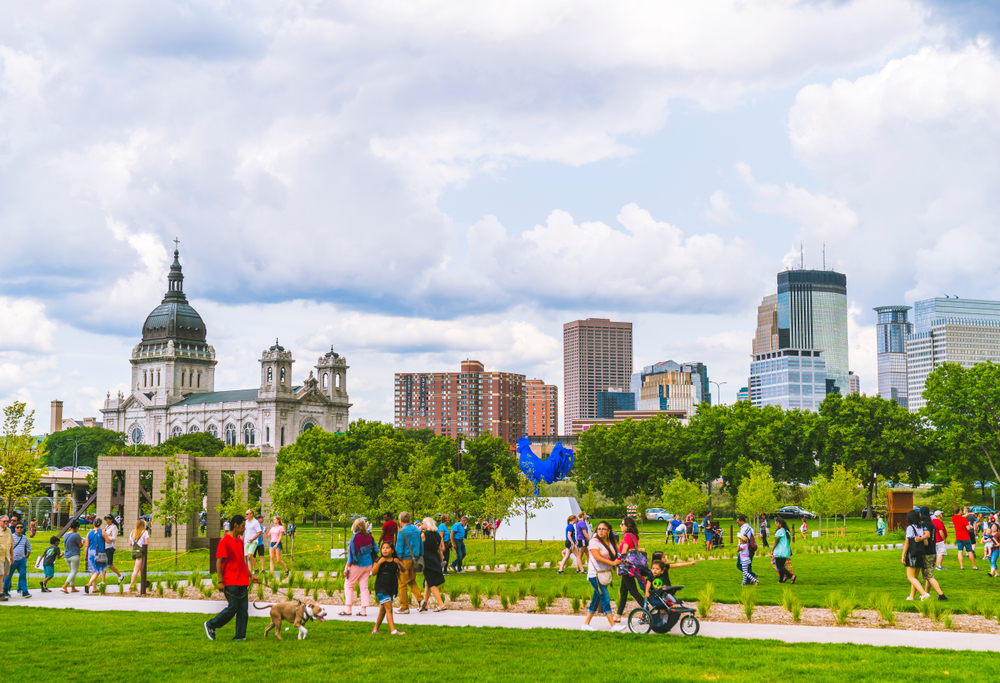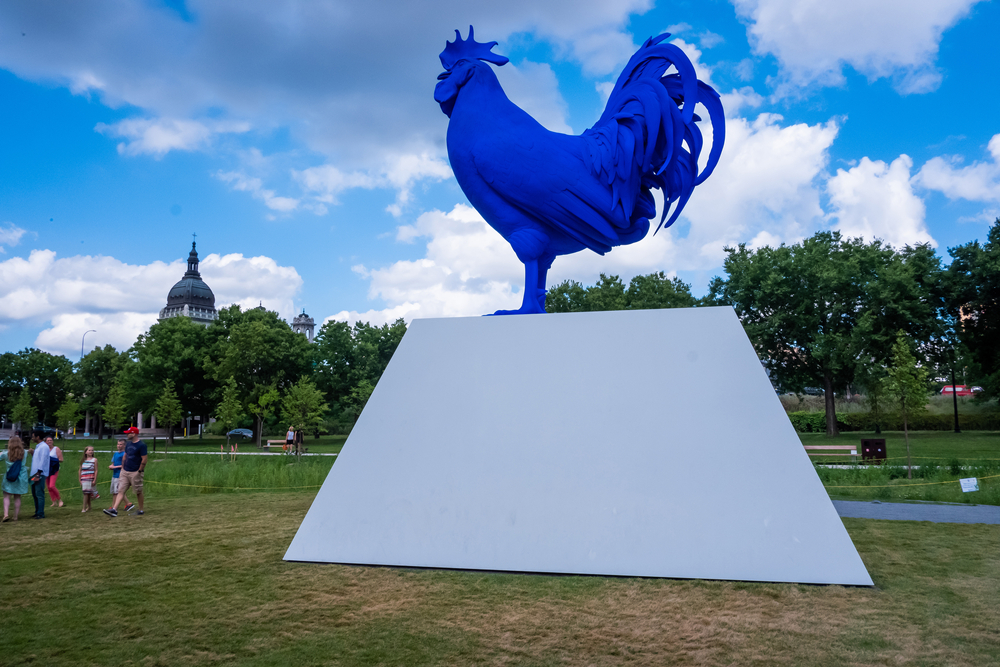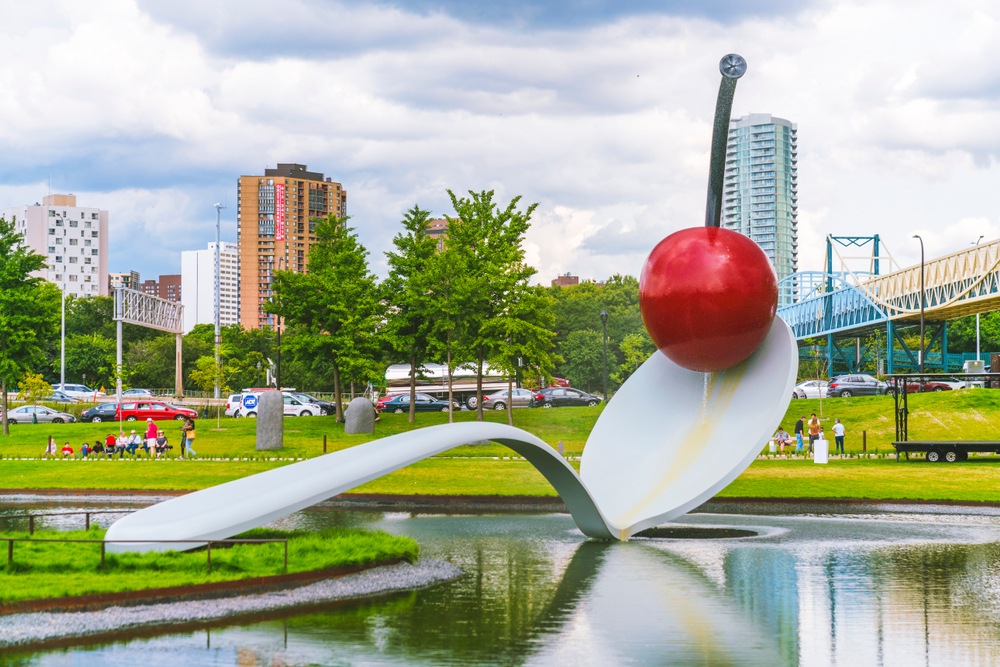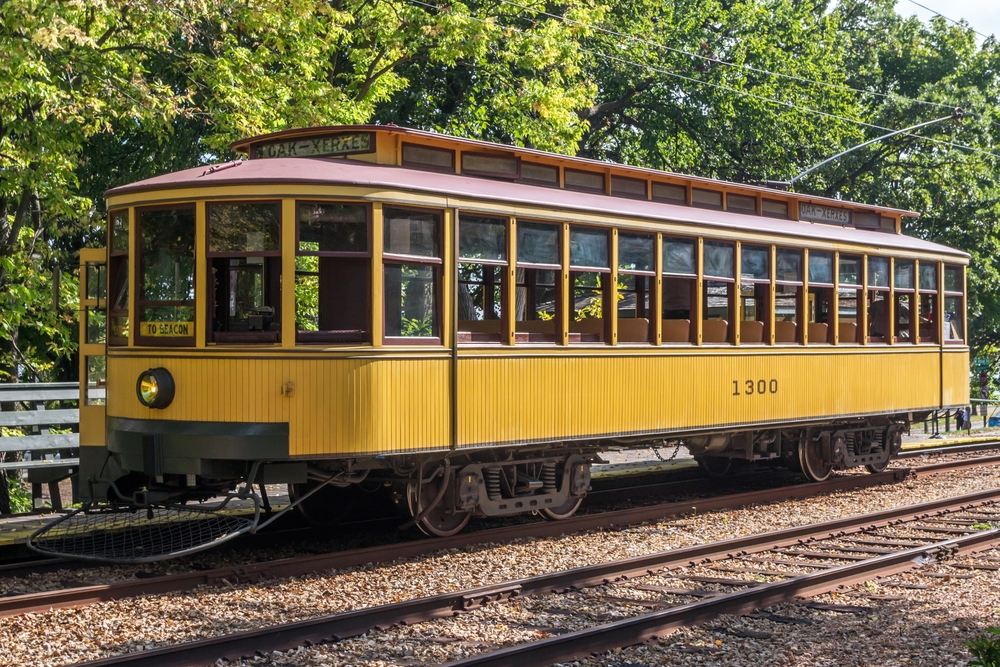The Minneapolis Sculpture Garden is a crown jewel of the city’s park system, uniting two of Minnesota’s most cherished resources—its greenspaces and its cultural life. The 11-acre site, home to the iconic “Spoonbridge and Cherry” sculpture, is a dynamic blend of art, nature, and urban life. It is a place where visitors can experience a diverse array of sculptures by both emerging and established artists, set against the backdrop of Minneapolis’s vibrant landscape.
History
The Minneapolis Sculpture Garden’s story began in the mid-1980s when the idea of a sculpture garden adjacent to the Walker Art Center was conceived. The garden was designed by landscape architect Michael Van Valkenburgh and opened in 1988, as a joint project between the Walker Art Center and the Minneapolis Park & Recreation Board. It quickly became one of the largest urban sculpture gardens in the country and has since served as a model for cities around the world.
Over the years, the garden has undergone several renovations and expansions to improve its facilities and accommodate its growing collection. The most significant of these was completed in 2017, marking the garden’s 30th anniversary. This renovation included the reconstruction of the garden’s infrastructure, the addition of new artworks, and the creation of new visitor amenities.
Facts
- The Minneapolis Sculpture Garden is one of the first major public/private urban sculpture parks of its kind in the United States.
- It features over 60 works from the Walker Art Center’s collections, including pieces by artists such as Claes Oldenburg and Coosje van Bruggen, Frank Gehry, and Mark di Suvero.
- The garden’s centerpiece, “Spoonbridge and Cherry,” was created by Oldenburg and van Bruggen and has become an iconic symbol of Minneapolis.
- The park is a successful example of how public-private partnerships can enhance public spaces, with support from the city, philanthropists, and the community.
Location
The Minneapolis Sculpture Garden is located near the heart of downtown Minneapolis, at 725 Vineland Place. It is situated across from the Walker Art Center, one of the nation’s leading contemporary art museums.
Website
For more detailed information on exhibitions, individual sculptures, and upcoming events, visit the Minneapolis Sculpture Garden’s official website: Minneapolis Sculpture Garden.
Opening Hours
The Minneapolis Sculpture Garden is open 365 days a year, from 6 am to midnight. It is accessible and free to the public, making art accessible to everyone, anytime.
Things to Do
- Explore the Art: Take a leisurely walk through the garden and enjoy the wide range of sculptures on display.
- Guided Tours: Join a guided tour to learn more about the artworks and the history of the garden.
- Photography: The garden offers countless photographic opportunities, whether you’re an amateur or a professional.
- Family Activities: Participate in family-friendly events and activities organized by the Walker Art Center throughout the year.
- Attend Events: The garden hosts many events, including performances, film screenings, and artist talks.
- Relax and Reflect: Find a quiet spot to sit and enjoy the peaceful surroundings or have a picnic on the lawn.
- Winter Activities: Even in winter, the garden’s beauty is accessible, with paths cleared for visitors to enjoy the sculptures against the snowy backdrop.
Tips For Visiting
- Check the Weather: Be prepared for Minneapolis’s varying weather conditions by checking the forecast and dressing appropriately.
- Wear Comfortable Shoes: Opt for comfortable footwear as the garden encourages exploration and has several walking paths.
- Visitor Amenities: Familiarize yourself with the garden’s amenities, including restrooms, parking, and accessibility features.
- Respect the Art: While photography is encouraged, touching or climbing on the sculptures is not permitted to preserve the artwork for future visitors.
- Plan Your Visit: Consider visiting during less busy times, such as weekday mornings, for a more tranquil experience.
- Use the Mobile Guide: Download the Walker Art Center’s mobile guide to enhance your visit with rich multimedia content.
- Volunteer Opportunities: If you’re a local or frequent visitor, consider volunteering at the garden to learn more and give back to the community.
- Donations: The garden is free, but donations to the Walker Art Center help maintain and improve the garden and its programs.
Conclusion
The Minneapolis Sculpture Garden is a testament to the city’s dedication to public art and urban beautification. It is a place where art, community, and nature intersect, providing a unique and enriching experience for all who visit. Whether you’re a local resident or a traveler, the garden offers a tranquil escape from the hustle and bustle of city life and a chance to engage with art in a natural setting. With its year-round accessibility, dynamic array of artworks, and commitment# Minneapolis Sculpture Garden
Introduction
In the vibrant city of Minneapolis, the Minneapolis Sculpture Garden stands as an emblem of artistic expression and urban landscape fusion. This esteemed garden, which spans across 11 acres, offers a serene retreat from the bustling city life, allowing visitors to immerse themselves in a world where contemporary art and nature meet. The garden, famed for its iconic “Spoonbridge and Cherry” sculpture, has become a must-visit destination for art enthusiasts and casual tourists alike.
History
The Minneapolis Sculpture Garden was born from a vision to integrate the cultural vigor of the Walker Art Center with the natural beauty of the city’s parks. Its inception dates back to the mid-1980s, and the garden officially opened its gates to the public in 1988. Esteemed landscape architect Michael Van Valkenburgh designed the garden with the intention of creating a harmonious space where art and horticulture could coexist.
Since its opening, the garden has seen several enhancements to its infrastructure and art collection, most notably in 2017, in celebration of its 30th anniversary. This renovation not only revitalized the space but also expanded its capacity to host a wider range of sculptures and installations.
Facts
- The Minneapolis Sculpture Garden was one of the pioneering urban sculpture parks in the United States.
- It showcases over 60 sculptures from the Walker Art Center’s extensive collections.
- The garden’s most recognized piece, “Spoonbridge and Cherry,” is the work of Claes Oldenburg and Coosje van Bruggen.
- This park exemplifies the successful collaboration between public initiatives and private philanthropy.
Location
The garden is situated at 725 Vineland Place, adjacent to the Walker Art Center, in the heart of Minneapolis. Its location makes it readily accessible to locals and visitors, serving as a cultural nexus within the city.
Website
To explore more about the Minneapolis Sculpture Garden, including current exhibitions, events, and specific sculptures, please visit the official website at Minneapolis Sculpture Garden.
Opening Hours
Open every day of the year from 6 am to midnight, the Minneapolis Sculpture Garden offers a flexible visiting schedule, ensuring that everyone has the opportunity to enjoy this public space at no cost.
Things to Do
- Art Appreciation: Stroll through the garden and discover a diverse range of sculptures.
- Guided Tours: Gain deeper insights into the artworks with a guided tour.
- Photography: Capture the beauty of the sculptures and their natural surroundings.
- Family-Friendly Activities: Engage in events designed for visitors of all ages.
- Seasonal Events: Experience the garden’s transformation with various seasonal events.
- Contemplation and Leisure: Find a quiet spot for reflection or enjoy a picnic.
- Winter Visits: Admire the stark beauty of the sculptures amidst a snowy landscape.
Tips For Visiting
- Weather Preparedness: Minneapolis’ climate can be unpredictable, so dress accordingly.
- Comfortable Footwear: With extensive grounds to explore, comfortable shoes are a must.
- Facilities: Make use of the visitor amenities, including accessible restrooms and parking.
- Art Preservation: Interact respectfully with the art, refraining from touching or climbing.
- Off-Peak Visits: For a more peaceful experience, consider visiting during quieter times.
- Mobile Guide: Enhance your visit with the Walker Art Center’s mobile guide app.
- Volunteering: Locals can give back and learn more by becoming a garden volunteer.
- Support the Garden: Donations are welcome to help maintain this free public space.
Conclusion
The Minneapolis Sculpture Garden is a testament to Minneapolis’s commitment to cultural and natural integration within an urban environment. It stands as a sanctuary for those seeking to engage with contemporary art in a refreshing, open-air setting. The garden’s blend of art, community, and nature makes it a unique destination, enriching the cultural tapestry of the city. Whether you’re a Minneapolis resident or a visitor, the Minneapolis Sculpture Garden promises an inspiring and tranquil experience, leaving a lasting impression of the city’s vibrant cultural landscape.








